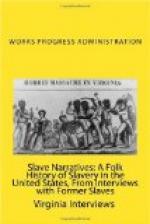“Where I was raised, Duggins wasn’t a mean man. His slaves didn’t get out to work till after sunup. His brother, who lived three miles out from us, made his folks get up before sunup. But Duggins didn’t do that. He seemed to think something of his folks. Every Saturday, he’d give lard, flour, hog meat, syrup. That was all he had to give. That was extra. War was going on and he couldn’t get nothing else. On Wednesday night he’d give it to them again. Of course, they would get corn-meal and other things from the kitchen. They didn’t eat in the kitchen or any place together. Everybody got what there was on the place and cooked it in his cabin.
“Before I was born, Beck sold my mother and father to Duggins. I don’t know why he sold them. They had an auction block in the town, but out in the country they didn’t have no block. If I had seen a nigger and wanted to buy him, I would just go up to the owner and do business with him. That was the way it was with Beck and Duggins. Selling my mother and father was just a private transaction between them.
Rations
“Twice a week, flour, syrup, meat, and lard were given to the slaves. you got other food from the kitchen. Meat, vegetables, milk,—all the milk you wanted—bread.
A Mean Owner
“Beck, Moss, Battle, and Duggins, they was all good people. But Kenyon Morps, now talk about a mean man, there was one. He lived on a hill a little off from the Duggins plantation. His women never give birth to children in the house. He’d never let ’em quit work before the time. He wanted them to work—work right up to the last minute. Children were all born in the field and in fence corners. Then he had to let ’em stay in about a week. Last I seen him, he didn’t have nothin’, and was ragged as a jay bird.
Houses
“Our house was a log house. It had a large room, and then it had another room as large as that one or larger built on to it. Both of these rooms were for our use. My mother and father slept in the log cabin and the kids slept back in the other room. My sister stayed with Joe Duggins. Her missis was a school-teacher, and she loved sister. My master gave my sister to Joe Duggins. Mrs. Duggins taught my sister, Fannie, to read and spell but not to write. If there was a slave man that knowed how to write, they used to cut off his thumb so that he couldn’t write.
“There was some white people wouldn’t have the darkies eating butter; our white people let us have butter, biscuits, and ham every day. They would put it up for me.
“I had more sense than any kid on the plantation. I would do anything they wanted done no matter how hard it was. I walked five miles through the woods once on an errand. The old lady who I went to said:
“‘You walk way down here by yourself?’




